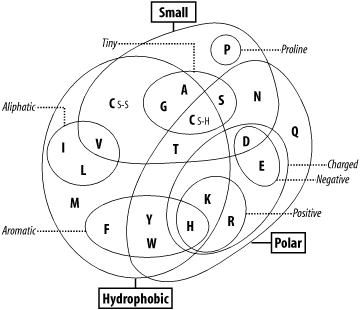A.2 Amino Acid Codes
| Amino acids are commonly referred to as the "building blocks" of proteins. The characteristics of each amino acid are dependent on their side chain, and they can be divided into several classes. These classifications are denoted as either polar, nonpolar, acidic, or basic. Figure A-1 shows the structure of an amino acid. Figure A-1. Amino acid structure Although trying to recall all of the amino acid names and their symbols may be a fun mental exercise, we've decided to include a table of amino acids. Table A-2 includes the names, three- and single-letter codes, side chains, and classification of each amino acid.
A.2.1 Properties SummaryAlthough there are four main classifications for amino acids, other characteristics may also be used to describe them. This is best illustrated in the properties diagram in Figure A-2. In the diagram, tiny is used to describe very short side chains, while small is used to denote small side chains. The terms aliphatic, aromatic and hydrophobic commonly refer to the chemical composition of the side chain of an amino acid. These types of side chains are typically composed of only carbon and hydrogen atoms. The terms charged, negative, positive, and polar designate the electronic characteristics of a side chain. The diagram is adapted from Livingstone & Barton, CABIOS, 9, 745-756, 1993 (http://www.ncbi.nlm.nih.gov/htbin-post/Entrez/query?uid=8143162&form=6&db=m&Dopt=bPubMed). Figure A-2. Summary diagram of amino acid properties |
EAN: 2147483647
Pages: 312
- Using SQL Data Definition Language (DDL) to Create Data Tables and Other Database Objects
- Working with Comparison Predicates and Grouped Queries
- Understanding Transaction Isolation Levels and Concurrent Processing
- Exploiting MS-SQL Server Built-in Stored Procedures
- Working with SQL Database Data Across the Internet





